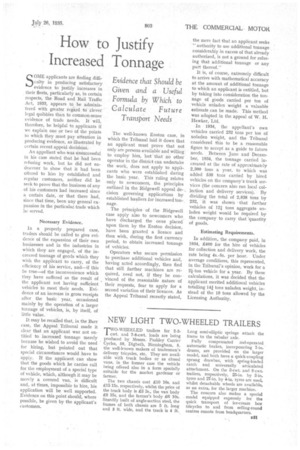How to Justify
Page 49

If you've noticed an error in this article please click here to report it so we can fix it.
Increased Tonnage SOME applicants are finding difficulty in producing satisfactory evidence to justify increases in , their fleets, particularly as, in certain respects, the Road and Rail Traffic Act, 1933, appears to be administered with greater regard to clever legal quibbles than to common-sense evidence of trade needs. It will, therefore, be helpful to applicants if we explain one or two of the points to which they must pay attention in producing evidence, as illustrated by certain recent appeal decisions.
An appellant who was Unsuccessful in his case stated that he had been refusing work, but he did not endeavour to show that it had been offered to him by established and regular customers, neither did he seek -to prove that the business of any of his customers had increased since a certain date, or that there had, since that time, been any general expansion in the particular trade which he served.
Necessary Evidence.
In a properly prepared case, traders should be called to give evidence of the expansion of their own businesses and in the industries in which they are engaged, of the increased tonnage of goods which they wish the applicant to carry, of the efficiency of his service, and—if this be true—of the inconvenience which they have suffered as the result of the applicant not having sufficient vehicles to meet their needs. Evidence of an increase in gross receipts after the basic year, occasioned mainly by the operation of a larger tonnage of vehicles, is, by itself, of little value,
It may be recalled that, in the Barr case, the Appeal Tribunal made it clear that an applicant was not entitled to increased tonnage merely because he wished to avoid the need for hiring, but pointed out that special circumstances would have to apply. If the applicant can show that the goods which he carries call for the employment of a special type of vehicle, which, although it may be merely a covered van, is difficult and, at times, impossible to hire, his application will be well supported. Evidence on this point should, where possible, be given by the applicant's customers. The well-known Enston case, in which the Tribunal laid it down that an applicant must prove that not only are persons available and willing to employ him, but that no other operator in the district can undertake the work, does not apply to applicants who were established during the basic year. This ruling relates only to newcomers, the principles outlined in the Ridgewell appeal decision governing applications by established hauliers for increased ton-, nage.
The principles of the Ridgewell case apply also to newcomers who• have discharged the onus placed upon them by the Enston decision, have been granted a licence and then wish, during the first currency period, to obtain increased tonnage of vehiclegl
Operators who secure permission to purchase additional vehicles and, having acted accordingly, then find that still further machines are required, need not, if they be convinced of the reasonable nature of their requests, fear to apply for a second variation of their licences. As the Appeal Tribunal recently stated, the mere fact that an applicant seeks "authority to use additional tonnage considerably in excess of that already authorized, is not a ground for refusing that additional tonnage or any part thereof."
It is, of course, extremely difficult to arrive with mathematical accuracy at the amount of additional tonnage to which an applicant is entitled, but by taking into consideration the tonnage of goods carried per ton of vehicle unladen weight a valuable estimate can be made. This method was adopted in the appeal of W. H. Hawker, Ltd, In 1934, the appellant's own vehicles carried 232 tons per ton of unladen weight, and the Tribunal considered this to be a reasonable figure to accept as a guide to future needs. Between .June andDecember, 1934, the tonnage carried increased at the rate of approximately 2,300 tons a year, to which was added 538 tons carried by hired vehicles on the company's hunk services (the concern also ran local collection and delivery services). By dividing the total of 2,838 tons by 232, it was shown that further vehicles of 12i tons aggregate unladen weight would be required by the 'company to carry that 'quantity of goods.
Estimating Requirements.
In addition, the company paid, in 1934, £400 for the hire of vehicles for collection and delivery work, the rate being 4s.-5s. per hour. Under average conditions, this represented, in the Tribunal's opinion, work for a 2i-ton vehicle for a year. By these calculations, it was decided that the applicant merited additional vehicles totalling 141. tons unladen weight, instead of the 10 tons allowed by the Licensing Authority.




































































































